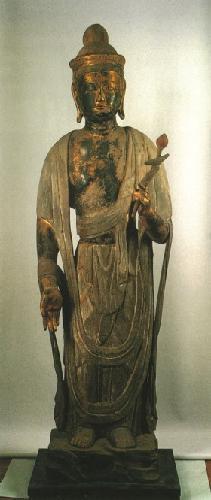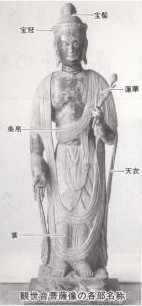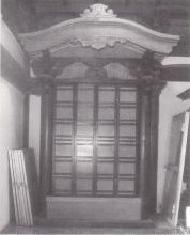The Kannon Bodhisattva statue at Koshoji Temple
Update date: June 27, 2017

Statue of Kanzeon Bodhisattva at Koshoji Temple
Sakahama Shingon Buddhism Toyoyama School Belongs to Koshoji Temple The museum is a cultural property designated by the Tokyo Metropolitan Government. Standing statue of Kannon Bodhisattva This Buddha statue was originally located on the same hill. Myofukuji Temple (now abandoned temple), but after the temple was abandoned Koshoji Temple It is said that it was moved to Koshoji Temple of Jizo Hall It is believed to have been made in the latter half of the Heian period (around the first half of the 12th century) and is enshrined at Jorakuji Temple. Amida Triad It is also said to be the oldest and most valuable Buddha statue in the city.
This Buddha statue is Zelkova wood Used One wooden structure The statue is 155.5 cm tall. Standing statue It is standing upright on the pedestal, with its right hand Drooping With your palm facing forward, your left hand is bent forward. Lotus flower The head is Topknot (Topknot) and eyes Carved Eyes From the left shoulder to the right armpit Textile It takes Heavenly clothes It hangs down from both shoulders, over the arms, and to the outside on both sides. Lacquer leaf ( lacquer After applying Gold Leaf The head, hair and clothes are painted, but nowadays most Flaking Only a small amount of the base remains.
The head and body are carved from a single piece of wood. Hollowed out No carving (removal of the inside of the statue) has been done. elbow Further ahead, Heavenly clothes of Free part The feet and objects being held are thought to be of later date.
One wooden structure It is made using an old technique called "ri". Downcast The mild expression and shallow Clothing line etc. Fujiwara period The characteristics of the late Heian period are evident. Narrow Face That both eyes are quite Nose Bridge (The bridge of the nose) Regular morning Style ( Buddhist sculptor Regular morning There are some differences from the elegant and harmonious Japanese style of Buddhist sculpture perfected by the Meiji Restoration. There have been various theories as to when it was made, ranging from the middle to the end of the Heian period. One wooden structure Typical Regular morning As it does not fall into any particular style, it is thought to date to the first half of the 12th century.
Also, Kannon Bodhisattva Statue Contain Shrine Although it has been significantly altered in recent repairs, Wooden nose or Middle-aged frog of Sculpture painting Therefore, it is believed to have been built between the end of the 17th century and the beginning of the 18th century. Kannon Bodhisattva Statue It can also be said to be a valuable cultural asset.

Main hall of Koshoji Temple

Name of each part of Buddha statue

Jizo-do Hall where Kanzeon Bodhisattva is enshrined

Zushi (inside Jizo-do Hall) where the Kanzeon Bodhisattva statue is enshrined












